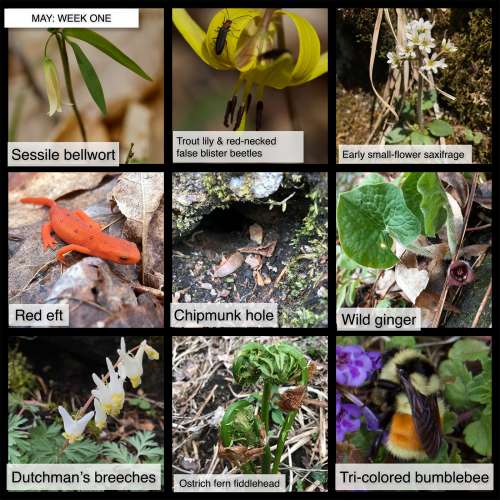This week in the woods, we’re noticing many more insects, including an abundance of tiny and hard-to-identify pollinators visiting spring wildflowers. Along with the increasing insect population, there has also been a surge in the diversity of voices in the morning bird chorus.
Bumblebees are back, including the common tri-colored bumblebee, which we’ve seen frequently this week in our yards and meadows. Here’s a helpful species page (with opportunity for more extensive bee exploration) from the Vermont Center for Ecostudies’ Vermont Atlas of Life.
Speaking of yards, for those of you who appreciate a feral lawn: check out all the dandelions and other lawn volunteers blooming right now, and see this Outside Story article from Michael Caduto, describing just-out-your-door foraging opportunities.
Trout lily is now coming into bloom, and we found its petals are crawling with red-necked false blister beetles. Here’s a note about them from Mary Holland’s “Naturally Curious” blog. (For a look at the plant’s distinctive dappled leaves, see the Third Week of April post in our archive.)
Also in bloom: early small-flower saxifrage. This little plant may not be our prettiest wildflower, but it has the virtue of toughness. It grows where most others can’t, including in thin soil on rocky outcroppings. Other blooming spring flowers we encountered this week include Dutchman’s breeches, wild ginger (the flower appears at the base of the plant and is often hidden in the leaves) and sessile bellwort, also called wild oats and many other names, which shows up in both woods and meadows.
With all the recent rain and damp leaves, red efts have been showing up on woods trails. These are immature eastern newts – the yellow-greenish newts you often see lurking in ponds and vernal pools. Both adults and young have a neurotoxin in their bodies, but the efts have it in much higher concentration; their bright coloration advertises this potency to would-be predators. For more information about amphibian skin and the sad story of a foolish duck, see this Outside Story article by Vermont Center for Ecostudies’ Steve Faccio.
Also easy to find right now, before summer foliage obscures them: chipmunk holes. They’re all over the woods, but if you want to try to identify multiple entrances for one burrow (a fun kid activity), a good place to look is a big tree with roots going out in all directions, curving over rocks.
Ferns are springing up, among them the ostrich fern fiddleheads. Look for a U shaped, non-hairy stem and brown paper casings attached in tatters to the curled frond. This video from UMaine Extension is helpful for identification.
In this difficult period, many of us find joy in observing local nature, and many families are seeking outdoor enrichment opportunities for children. Here are nine photographs taken this past week in forests within 15 miles of the Northern Woodlands office in Lyme, New Hampshire. We hope you enjoy using this grid as a prompt for your own explorations, or as the basis for a game of family forest tic-tac-toe.
What are you seeing in the woods this week? Share your images with us on Facebook, or submit a special photo for possible inclusion in our monthly online Reader Photo Gallery.


